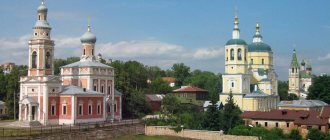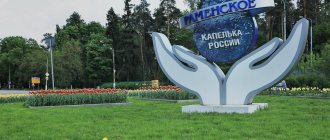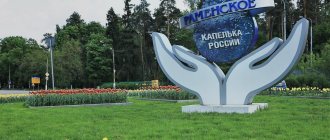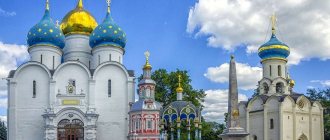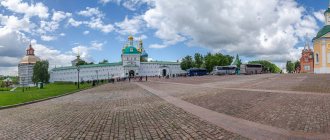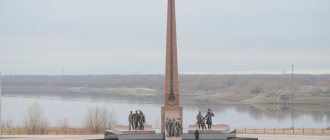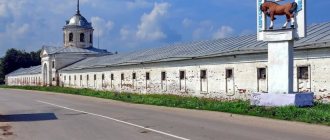Sergiev Posad is a city near Moscow, located in the northeast of the Moscow Region, 52 km from the metropolis. The center of the Sergiev Posad district, part of the Golden Ring. There is the main attraction of Sergiev Posad - an architectural historical monument of art and culture, included in the UNESCO List - the Trinity-Sergius Lavra, with an area of 50.4 km2.
In the 1340s, a church and a monastic cell were built on the site of the future town. Afterwards, a monastery arose there, in which the followers of Sergius of Radonezh served. In 1422 he was recognized as a saint. Trinity Cathedral was built over his grave. In 1408, the monastery was burned by Khan Edigei. After it was restored, Ivan the Terrible was baptized there. This is where he was buried.
In troubled times for 1.5 years, the monastery repelled the attacks of the Poles and Lithuanians. In 1744 it was given the status of a Lavra. In 1845, the city and the capital were connected by a highway, and 17 years later a new railway line was built. In 1919 the city was renamed, and only in 1991 its historical name was returned.
Ecology in the city of Sergiev Posad
Winter there is mild, not very hot and not too cold. In summer, the rainiest month is July. But the city also has disadvantaged areas where manufacturing enterprises are located. Because of this, it is difficult to breathe there, the air is filled with harmful substances.
Sergiev Posad is an industrial city and there are quite a lot of factories in such an area. There is only one machine-building enterprise that has been operating in the Moscow region for about 20 years. During all this time, the ecology in this area was so spoiled that Muscovites wondered whether it was worth moving to Sergiev Posad.
Significant dates
Today in history
- 102 years old
102 years ago, on February 8, 1920, the first subbotnik took place in the city.
102 years ago, on February 12, 1920, the Sergiev Komsomol was born - the first Komsomol cell was created in the city.
143 years ago February 1 (14), 1879, anniversary of the publication of the first issue of “Trinity Leaves”
272 years ago, on February 1 (14), 1750, the “Tsar” was brought to the Lavra
- 103 years old
103 years ago, on February 15, 1919, the general meeting of the City Council raised the issue of renaming Sergievsky Posad.
148 years ago, February 5 (17), 1874, a resolution to increase the monthly salary of police officers
321 years ago, on February 6 (17), 1701, bells taken from the belfries of the monastery were brought to the Cannon Yard
- “In the 1340s,” describes Epiphanius the Wise, who compiled the biography of Sergius of Radonezh at the beginning of the 15th century, “in a dense forest on the Makovets hill at the confluence of the Konchura river with the forest stream Vondyuga, the brothers Bartholomew (in monasticism Sergius) and Stephen cut down a cell and a small church in honor of the Trinity." Around the cell and the church a small monastery was formed in the form of a town, surrounded by a fence, where monks, followers of Sergius of Radonezh, served.
- In 1380, Prince Dmitry Donskoy, according to a later unreliable legend, arrived at the monastery of Sergius of Radonezh for a blessing before the battle on the Kulikovo Field with the troops of the Golden Horde.
- St. Sergius died in 1392. In 1422, the canonization of St. Sergius took place and the laying of the white stone Trinity Cathedral over his grave inside the monastery took place.
- In 1408, the monastery was burned to the ground by the Tatar Khan Edigei, who launched another devastating campaign against Moscow and its environs.
- Ivan the Terrible was baptized in the monastery, who contributed to the transformation of the monastery into a powerful fortress that had important defensive significance for the Moscow region. Instead of a wooden fence in 1540-1550. a powerful wall with towers made of brick and stone was built. Ivan the Terrible, according to his will, was buried in the Archangel Cathedral of the Moscow Kremlin.
- In 1608-1610. The monastery was under siege by Polish-Lithuanian troops for 16 months.
- Peter I maintained the significance of a royal and important state fortress and visited the monastery more than once, and in 1689, during the Streltsy riot in Moscow, young Peter took refuge behind the walls of the monastery.
- In 1744, by decree of Empress Elizabeth Petrovna, the monastery was awarded the honorary title of Lavra, which strengthened its status role among other church institutions.
- In 1845, a highway was built connecting Sergievsky Posad with Moscow.
- In 1862, Savva Morozov built a railway line that included the Sergiev Posad station.
- In 1919, the city was named Sergiev, it became the center of Sergievsky district.
- In 1930 it was renamed Zagorsk in honor of the revolutionary figure V. M. Zagorsky.
- On January 20, 1930, the city of Sergiev was renamed Zagorsk, and the district was renamed Zagorsky District.
- On May 20, 1930, Bulakovsky and Novlensky s/s were transferred from Shchelkovsky district to Zagorsky.
- On November 13, 1931, the Trinity-Slobodsky s/s was abolished.
- On May 10, 1935, Yazvitsky s/s was abolished.
- On October 27, Bulakovsky and Novlensky s/s were returned to the Shchelkovsky district.
- On April 5, 1936, the Malyginsky and Yaryginsky s/s were abolished.
- On December 26, 1938, the working village of Khotkovo was formed. Khotkovsky s/s was abolished.
- On July 17, 1939, Bogorodsky, Vikhrevsky, Grigorkovsky, Deulinsky, Zubtsovsky, Novinkovsky, Smenovsky, Chizhevsky and Yakovlevsky s/s were abolished. Kozitsynsky s/s was renamed Bereznyakovsky, Torgashinsky - Okhotinsky, Saburovsky - Alferevsky.
- On September 19, the village of plant No. 11 was transformed into a settlement. Krasnozavodsky.
- On July 6, 1940, the holiday village of Semkhoz was formed.
- October 7 r.p. Krasnozavodsky was transformed into the city of Krasnozavodsk.
- On March 7, 1941, Zagorsk received the status of a city of regional subordination.
- On March 5, 1943, the village of Mukhanovo was transferred from the Struninsky district of the Ivanovo region to the Zagorsky district.
- On April 22, Mukhanovo received the status of a workers' village.
- July 27, 1949 r.p. Khotkovo received city status.
- On May 22, 1952, a d.p. was formed. Abramtsevo.
- On June 14, 1954, Alferevsky, Gorbunovsky, Divovsky, Dushishchevsky, Ereminsky, Iudinsky, Leonovsky, Malinnikovsky, Morozovsky, Ozeretsky, Okhotinsky, Repikhovsky, Svatkovsky, Sosninsky, Teshilovsky and Sharapovsky s/s were abolished. Buzhaninovsky, Kamensky and Mitinsky s/s were formed.
- On December 7, 1957, Bogorodsky, Veriginsky, Zabolotevsky, Skovorodinsky, Konstantinovsky, Kuzminsky, Novoshurmovsky, Selkovsky, Khrebtovsky and Chentsovsky s/s s/s of the abolished Konstantinovsky district were annexed to the Zagorsky district.
- On December 30, 1959, Akhtyrsky, Zabolotevsky, Novoshurmovsky and Selkovsky s/s were abolished. Khrebtovsky s/s was renamed Torgashinsky.
- On February 1, 1963, the Zagorsky district was abolished. At the same time, the cities, summer cottages and workers' settlements that were part of it were transferred to the subordination of the city of Zagorsk, and the village councils were transferred to the Mytishchi enlarged rural district.
- On January 22, 1965, the Zagorsk district was restored to its previous composition.
- On December 2, 1976, Vorontsovsky and Maryinsky s/s were abolished.
- On October 25, 1984, r.p. were formed. Bogorodskoe and Skoropuskovsky. Vypukovsky s/s was abolished.
- On August 27, 1990, Kamensky s/s was renamed Maryinsky, and Bogorodsky - Shaburnovsky.
- On January 9, 1991, Selkovsky s/s was formed.
- On September 23, 1991, the city returned its historical name Sergiev Posad.
- On February 3, 1994, village councils were transformed into rural districts.
- On March 28, 2000, the city of Peresvet was formed.
- September 14, 2004 d.p. Semkhoz was annexed to Sergiev Posad. At the same time d.p. Abramtsevo and r.p. Mukhanovo were transformed into rural settlements.
Transport infrastructure and accessibility
Communication with the metropolis is well developed - the settlement of the Moscow region has several railway stations "Semkhoz" and "Sergiev Posad", which can be reached from any area. 1.5 hours to Yaroslavl highway. Several times a day, a train runs there, reaching the capital in 60 minutes.
From the bus station there is a bus to the station. "VDNKh". But this route is not popular, despite the reconstruction of the highway on Yaroslavka there are constant traffic jams.
There are many minibuses and taxis inside the city. Getting to any microdistrict will not be difficult. And moving around Sergiev Posad in a personal car is difficult.
Shalin Alexander Evgenievich, real estate broker, City Real Estate Department
“The biggest problem of the town near Moscow is constant traffic jams at the exit from the settlement, which is already a nightmare for motorists. Local residents working in the metropolis are forced to wake up early to avoid this terrible rush hour. There are also problems when moving along the main highway of the city. On weekends there is a big influx of tourists."
A bypass with a length of 11 km, with 4 exits and a transport hub is being built. The new highway goes towards Semkhoz, passes through a tunnel in front of the railway tracks and comes out at a roundabout. The bus station and railway station can be moved to the transport hub, and a walking route will run from the old square.
How the city changed its name
24 years ago the city of Zagorsk became Sergiev Posad. On September 23, 1991, a resolution was issued by the Presidium of the Supreme Soviet of the RSFSR on the renaming. And although the date is not round, we decided to remind our readers of those events. Yuri Stepanov, who was at that time deputy editor of the newspaper “Forward,” agreed to help us with this.
What should we call you now?
A distinctive feature of the Soviet period in the history of our country was the massive renaming of cities. Vyatka began to be called Kirov, Tver - Kalinin, Ekaterinodar - Krasnodar, Perm - Molotov. Even Rybinsk managed to change its name to Andropov, Izhevsk to Ustinov, and Naberezhnye Chelny to Brezhnev. With the collapse of socialism, the reverse process began.
With the beginning of Gorbachev's perestroika, voices began to be heard more and more often about the need to get rid of the ideological heritage of the past. First of all, the renaming of large cities was discussed - Leningrad, Sverdlovsk, Gorky. The name change was preceded by a wide public debate, from disputes in kitchens to controversy in the press. On the one hand, there were calls to restore historical justice and return to one’s roots, on the other hand, it was believed, not without reason, that in a society of reigning shortages, rising crime and impoverishment of the masses, there were more important things to do than changing toponyms.
Over the mountains, over the valleys...
Yuri Stepanov believes that Zagorsk, unlike many other cities, by its name was little associated with Bolshevism. If the residents of Zagorsk themselves knew that their city was named in honor of the revolutionary Vladimir Zagorsky, who died in 1919 from a bomb of the left Socialist Revolutionaries, then, for example, visitors to the city were often sincerely convinced that Zagorsk was “somewhere over there, just over the mountains.” Remember the poems of Agnia Barto: “from hill to hill in the city of Zagorsk”?
In general, the figure of Zagorsky in the pantheon of revolutionary heroes turned out to be pushed into the far corner. By the way, local historians “unearthed” such a historical incident. When at the end of the 1920s the question arose about the next renaming of the city (by that time it was called Sergiev), Zagorsky was proposed for this purpose, but not Vladimir Mikhailovich, but another - Nikolai Fedorovich. Unlike his Moscow colleague, this character carried out his revolutionary activities on the territory of our region, calling on workers of local factories and factories to strikes and rallies back in 1905.
No need to rush!
According to the interlocutor’s recollections, the “locomotive” of the idea of renaming Zagorsk was the local intelligentsia. She was very active at that time. The Council of Creative Intelligentsia periodically met in the Gorlovsky Library, where discussions were held on how to further develop the city, how to solve problems of education, culture, and ecology. And the authorities supported this movement, and some officials themselves did not hesitate to take part in it. For example, the chief architect Viktor Zhuravlev was always a welcome guest.
And yet it cannot be said that the majority of the population of Zagorsk and the region were in favor of changing the name. Although after the monument to St. Sergius of Radonezh was unveiled in May 1988 in the village of Gorodok (now Radonezh), it became clear that “the process has begun.”
But public opinion was still far from ambiguous. An indicative incident occurred during the election campaign for the election of a deputy to the Congress of People's Deputies of the USSR in 1989. Then the famous TV journalist and candidate for deputy Alexander Krutov came to Zagorsk to meet with voters. He is known to the older generation as the host of the popular television program “Spotlight of Perestroika” in the late 1980s. The event took place at the House of Culture named after. 50th anniversary of the October Revolution on Skobyanka. There were a lot of people then—the hall was full. At the peak of his speech, the future people's deputy with pathos called on the masses to rename Zagorsk, hoping that people would enthusiastically support him. However, deathly silence reigned in the hall. The TV journalist got excited. And later he chose another hobby for himself - closing the Shemetovsky radioactive waste site.
In general, it became clear that the residents of the city were quite happy with the old name and they saw no reason to change it. But supporters of the renaming also did not sit idly by. During the next elections at Zagorsk polling stations, a population survey was simultaneously organized, which, although it did not have official status, was supposed to demonstrate the attitude of city residents to a possible renaming. Its results showed that society is divided on this issue.
It's finished!
And yet, on September 2, 1991, a session of the City Council decided to return the city to its historical name - Sergiev Posad. 81 deputies voted “for”, 25 “against”, with 12 abstentions. This made it possible to include the city of Zagorsk in the resolution of the Presidium of the Supreme Soviet of the RSFSR of September 23. In it, our city was adjacent to Sverdlovsk, which received its former name Yekaterinburg. A week after the release of the fateful document, on October 1, its text was published in the regional newspaper “Forward”.
In parallel with the discussion about changing the name of the city, issues of toponymy of city streets were always discussed, recalls Yuri Stepanov. This was inevitable, because to have streets in the historical center of Sergiev Posad with the names Proletarskaya, Pervomaiskaya, Komsomolskaya, you will agree, is wonderful and wild. And they soon became Ilyinskaya, Voznesenskaya, and Bethany, respectively. Instead of Vokzalnaya, Sergievskaya Street appeared, Rosa Luxemburg Street became Leonid Bulavin Street, and Novo-Zagorskaya Street became Kulikov Street. Zagorsky Street remains - it does not bother anyone outside the historical center. But Karl Marx Street stands there unshakably.
Returning to the name of the city, we note that the word “Zagorsk” continues to live its own life. Zagorsk optical-mechanical plant, Zagorsk pumped storage power plant, the village of Zagorskie Dali... When the famous Parisian fashion house Comme des Garcons released its famous collection of fragrances “Religions of the World” in 2002, it called the perfume dedicated to Orthodoxy not something, namely “ Zagorsk".
Alexey Michkov
Photo by Alexey Sevastyanov
Population in a town near Moscow
There are 107,000 inhabitants living in the settlement, not counting migrants and tourists. There are old ladies selling flowers, bright-looking teenagers, office workers, football fans. Without hooligans disrupting order in the city, there is also nowhere. But the people are quite friendly. Many residents have higher education and graduated from Moscow institutes.
There are no beggars in the city district. There are also few young mothers on playgrounds. Birth statistics in the city have dropped sharply. There are more and more visitors. Many are attracted by the history and attractions of the locality.
Infrastructure: shopping centers, shops and restaurants
Before moving to Sergiev Posad for permanent residence, many are interested not only in salary. The town’s opportunities are also relevant for migrants.
The city has almost all the Moscow chain stores, shopping centers and local retail outlets, most of which are concentrated near the Moscow Highway and Red Army Ave. There are many shopping centers near the Novouglich highway and train stations.
Shopping center Sergiev Posad:
- Shopping center "Capitol" - 56.34136, 38.12405;
- Shopping center “Happy Family” – 56.30646, 38.13290;
- Shopping center "Park" - 56.30037, 38.17461;
- Shopping center "Manifesto" - 56.32417, 38.14406;
- Shopping center "Voznesensky" - 56.30351, 38.13427;
- Shopping center "Rainbow Styles" - 56.33121, 38.14217;
- Shopping center “Udacha” – 56.34319, 38.12794.
Children's products can be bought at the Children's World on Ptitsegradskaya Street. Products in the stores “Dixie”, “Taste of Villas”, “Perekrestok”.
Network shops:
- “Krusta” - 56.33304, 38.15548;
- "Fix Price" - 56.31520, 38.13467;
- “Taste of Villas” – 56.31463, 38.13502;
- “Faithful” – 56.32434, 38.13570;
- "Dixie" - 56.31691, 38.13725.
There are also many restaurants and cafes there. After all, many tourists come to the city wanting to see local attractions.
The best cafes and restaurants in Sergiev Posad:
- restaurant-museum "Guest Hut" - 56.31414. 38.13176;
- restaurant "Red Chambers" - 56.31300, 38.13450;
- restaurant “Varenichnaya” – 56.31404, 38.13588;
- cafe "Landau" - 56.31395, 38.13691;
- cafe-restaurant “Russian Yard” – 56.31186, 38.13347;
- Georgian restaurant “Pirosmani” – 56.31319. 38.13519;
- cafe "Coffee Shop" - 56.31585, 38.13588.
Local residents recommend going to the Lagmannaya cafe; the food is very tasty; you can have dinner or lunch in the restaurant or take your favorite dish with you. Prices are moderate, the average bill is 1,000 rubles.
Interesting Facts
There are interesting facts associated with the city. In general, this area is rich in stories and legends. You can get complete information about them on the excursion. We definitely recommend using the services of guides and then exploring the city and its surroundings on your own.
So, let's present the 10 most interesting facts:
- Sergiev Posad is included in the list of the most ancient cities of the Russian Federation.
- The area of the city is 50x50 sq. kilometers. It is twice the size of the Pacific country of Tuvalu.
- This is the only city of the Golden Ring located in the Moscow region.
- The Trinity-Sergius Lavra includes more than fifty architectural objects, and the entire complex is protected by UNESCO.
- It is believed that Sergiev Posad is the birthplace of the Russian nesting doll.
- At one time, N. Gogol, L. Tolstoy, A. Akhmatova, Yu. M. Lermontov came here.
- Ivan the Terrible was baptized in a local church.
- More than 300 thousand pilgrims come to Sergiev Posad every year. At the same time, the Chinese make up more than half of the tourists.
- There are only two laurels in Russia. One of them is located in St. Petersburg.
- The Trinity-Sergius Lavra houses the largest bell on the planet. Its weight is 72 tons.
You will learn even more interesting facts when visiting the city.
Parks, places for recreation with children
In the tourist city there are 7 libraries, “Spring” and “Horizon”. The educational theater “Theatrical Ark” is located there.
DRC of the Moscow region:
- DTS "Drugalki" - 56.32764, 38.13397;
- family amusement park "Nevidalia" - 56.34201, 38.12436;
- amusement park – “Park of Miracles” – 56.31936, 38.13466;
- children's club "Wonderland" - 56.33107, 38.15563;
- children's club "New Generation" - 56.30560, 38.14230;
- “Laboratory of Creativity and Science” – 56.32858, 38.15053;
- children's creativity center "Krugozor" - 30335, 38.17596.
The construction of the Ice Arena has been completed in the city. Numerous sports centers and fitness clubs.
The town has parks and squares with historical sights. There are plenty of things for tourists and locals to take a walk and see in Sergiev Posad.
The best park areas of the city of the Moscow region:
- Skitskie Prudy Park – 56.30353, 38.16532;
- Shopping center “Park” – 56.30113, 38.17423;
- central park – 56.28688, 38.08809;
- historical monument “Memorial Square” - 56.33100, 38.14516;
- fountain at the Gagarin Palace of Culture - 56.31877, 38.13742;
- observation deck “Pancake Mountain” – 56.30868, 38.13416;
- sculpture “Sergius and the Doves” – 56.30882, 38.13503.
There is also plenty of entertainment in the city: karaoke clubs, nightclubs, bars. There are several yoga centers and dance studios, and equestrian clubs. The famous studio of Alla Dukhovna “Todes” is also located there.
M.O. hotels and hotels
Many tourists come to the city, thanks to which the hotel business is quite developed there. In the urban district of Moscow Region there are hotels of different classes.
Best hotels:
- “Barskie Polati” – 56.31268, 38.14029;
- Hotel "Central" - 56.31230, 38.13565;
- hotel "Rodina" - 56.30554, 38.13393;
- Hantry Hotel – 56.31972, 38.13256;
- “Old Hotel Lavra” – 56.31373, 38.13325;
- hotel “Vladimirskaya” – 56.31630, 38.13840;
- guest house "Shishkina" - 56.31430, 38.13737.
The cost of renting a room per day depends on the location of the hotel, services and amenities that the hotel offers its guests. Average price 2-6 thousand rubles.
Social infrastructure of the town
In Sergiev Posad there are about 12 schools, an evening school, a correctional school and three primary schools and kindergartens, various specialized institutions: a gymnasium on Voznesenskaya and a physics and mathematics lyceum. There are several more gymnasiums there - Orthodox and No. 5. On Novgorodskaya there is a private kindergarten-school “Darovanie”.
There are 18 kindergartens in the town, and several private ones. On Vladimirskaya there is a modern institution with a swimming pool. For additional education, the authorities have provided specialized schools - a music school and an art school.
Profile institutions and additional education:
- music school "Moralmemes" - 56.29584, 38.12765;
- children's art school - 56.30632, 38.18258;
- Children's Music School No. 3 – 56.30165, 38.15100;
- music school "Lux" - 56.33476, 38.13593;
- Lyceum – 56.28821, 38.06637;
- evening school – 56.31145, 38.12336;
- Higher School of Folk Arts - 56.32973, 38.13778.
There are many clubs for children in the town: the center “Universe of Speech”, “Klaverin”, the “Vesnushka” club, the Montessori center.
To get higher education and secondary specialized education, you don’t need to leave anywhere. There is someone to study there. Technical school of toys, medical school, cooperative and socio-economic, economics and law colleges.
Among the universities in Sergiev Posad we can highlight:
- Sergiev Posad Humanitarian Institute - 56.29334, 38.12319;
- branch of the Moscow Academy of Finance and Law - 56.28269, 38.12637;
- Witte University - 56.33342, 38.16066;
- Moscow Humanitarian University named after Sholokhov - 56.33116, 38.16230.
The city is home to a mechanical engineering university, branches of VGIK and MPGU. There you can get a good education for future promising employment.
Recreation centers and where to choose for a weekend with family and children
There are many historical places in the city. Sergiev Posad is famous for its historical past. Architectural and historical monuments remain from ancient times. The surroundings of the Moscow region attract many tourists with their beauty.
Park Hotel "Peresvet"
Located in a forested area 30 minutes from the city. You can relax there with your family and noisy company. All conditions for a comfortable stay have been created here. Rooms of different categories with classic interiors. Free internet, private bathroom and appliances. At the restaurant, guests can try Russian and European cuisine.
Boarding house "Voskhod"
Located in the picturesque place of Sitniki. The rooms are decorated in light colors. Furnished with all necessary furniture. There is a split system, a bathroom with a shower. The restaurant prepares a variety of dishes to order. There are barbecue areas. To the airport – 116 km, railway station – 180 km.
Hotel "Russian Seasons"
Located in Sergiev Posad. A transfer service and guarded parking are provided. Comfortable rooms: TV, air conditioning, bathroom, bath amenities. There are bars, cafes and restaurants on the territory of the complex; food can be ordered to your rooms. There, there is billiards, surfing, a sauna, a swimming pool, a massage room and a gym.
What to see in the vicinity of Sergiev Posad
15 km from Sergiev Posad there is an amazing open-air ethnic park “Nomad”. Here are the dwellings of nomadic tribes. You will be able to get acquainted with the life, culture and traditions of different nationalities. In addition, you will see exotic animals: deer, northern dogs, Kalmyk camels, yaks and other representatives of northern latitudes.
The Abramtsevo estate also deserves attention. This is a kind of museum-reserve. S. Aksakov once lived here, and later Savva Mamontov began to own the estate. No less famous guests came to the estate to visit the famous owners. The estate is located 20 kilometers from the city.
Guests of Sergiev Posad certainly go to Gremyachiy Klyuch. This source, as local legend says, was begged by Sergius of Radonezh. Its waters are considered healing. People come here to ask the Almighty for health. The territory is landscaped. The attraction is located 28 km from the city.
The Muranovo Estate Museum is 30 km from Sergiev Posad. At one time, people who belonged to the sphere of writers lived here; F. Tyutchev was among the owners. The main exhibitions are dedicated to him. The idea of creating such an institution belongs to the leader of the Soviet people - V. Lenin.
And the village of Vasilyevo will appeal to fans of folklore. 40 kilometers from the city is the Museum of Slavic Fairy Tales and Mythology. Young travelers really like the interactive complex.
In Khotkovo (15 km) there is an interesting institution - the Raccoon House. Here you can observe the life and habits of the animals, feed them and take memorable photographs.
Where can you go with children?
A trip to the Moscow region will be interesting and educational not only for adults, but also for children. Local residents recommend visiting several places.
Art Museum Toys
Since 1910, Nikolai Bartram began to collect an interesting collection. The museum was opened only in 1918. Innovative, entertaining methods of working with children - this brought him great success. In terms of attendance in the 20s, only the Tretyakov Gallery was superior. Now it is a unique museum in Sergiev Posad.
Museum of Impressions
There is an exhibition of 3D paintings. Here you can take a photo, see a mysterious ribbon labyrinth, a room with soap bubbles, and take part in a quest in which you need to unravel the mystery of the old factory and discover the exit.
Ethnic Park "Nomad"
Located near Khotkovo. There, you can find out how the nomads lived, visit the zoo and camel farm. Among the inhabitants of the ethnopark are goats and sheep, rams, donkeys, yaks and geese. Excursions and lectures are also held here, and there is a shadow and puppet theater for children.
City museums
If you visit Sergiev Posad on your own, don't miss out on the unusual Toy Museum. Its exhibition includes more than 150 thousand of a wide variety of items created by craftsmen for the enjoyment of children. There are toys from both foreign and domestic masters. Sergiev Posad is even known in the world as the “Capital of the Kingdom of Toys”. Therefore, you can take children on the trip too. They won't be bored.
Legend has it that toys were made on the territory of the Trinity-Sergius Lavra 200 years ago. Local residents sold them to pilgrims who arrived to visit the monastery.
Be sure to check out the Museum of Soviet Childhood. Here are collected toys and board games that replaced gadgets for children in the last century. Adults speak highly of the visit. They claim that it is as if they were momentarily transported back to their childhood.
Visit the Sergiev Posad Museum-Reserve. It was founded 100 years ago, and its fund includes over 100 thousand storage units. There are icons, silver utensils, religious objects, and paintings by famous painters.
The Horse Yard is popular. This is also a museum. Previously, the building housed a stable. Now there are several regular exhibitions within the walls of the Horse Yard. One of them is dedicated to the Russian nesting doll. Other exhibitions tell about life in the Russian village and about applied art. Real masterpieces created by the hands of folk craftsmen are exhibited here.
The Museum of Peasant Life "Once Upon a Time" belongs to V. Bagrov. A local artist has put together a unique collection. You can admire homespun clothes made in the last century, clay and wooden household items, kitchen utensils, and a collection of semi-precious stones.
In the house of Pavel Florensky, who is called the Russian Leonardo de Vinci, the furnishings that existed during the life of the priest, scientist, and painter have been preserved. There is a piano here. The brilliant inventor made it with his own hands. He was shot by the Bolsheviks. You can walk around Sergiev Posad all day and discover more and more new sights. We have listed only the most popular among tourists, but the list of religious monuments, museums, and exhibitions does not end there.
Where to go outdoors and barbecue
Sergiev Posad is a cozy town with its own attractions. There are not only unique cultural monuments located there, but also some of the most beautiful natural places.
The city opened its first official picnic area. On the territory there are 6 tables with benches, 6 barbecues, with a canopy and trash cans. The place is located on the coast of the Vaulina Dam. The landscaped area with barbecues is the first in the city district, and the 7th in the region.
Cultural and historical attractions
Sergiev Posad is the only town on the Golden Ring where there are not many ordinary tourists. This is the center of Orthodoxy in Russia, receiving numerous pilgrims and admirers of Sergei of Radonezh.
Top attractions of Sergiev Posad:
- Pancake Mountain – 56.30970, 38.13414;
- Museum “Once Upon a Time” – 56.31532, 38.13980;
- Museum-Reserve "Horse Yard" - 56.31465, 38.13328;
- Church "Chernigov Skete" - 56.30989, 38.17980;
- Holy Trinity Sergius Lavra - 56.31237, 38.12933;
- museum-reserve – 56.31465, 38.13534;
- Church of the Nativity of John the Baptist - 56.31246, 38.13208;
- Kelarsky Pond – 56.30856, 38.12899;
- Spaso-Vifansky Monastery - 56.28948, 38.17709.
The city is home to the Trinity Cathedral, the Holy Spiritual Church, the famous tomb of the Godunovs and the Stavropegial Monastery.
Work, industry and business
Sergiev Posad is the industrial center of the Moscow region. There are places to work without higher education here. Residents from other surrounding areas also come here. Some of the largest factories offer work:
- furniture manufacturing;
- electromechanical plant;
- cold storage and meat processing plants;
- ice cream factory and confectionery plant;
- tea-packing factory.
Some residents work in cafes, restaurants, hotels, museums, and souvenir shops. Such promising employment is absent in many towns in the Moscow region. There are many offices and business centers in the village. But despite this, residents go to work in Moscow.
Enterprises provide a good work base. They not only provide stable work, but also supply the city with local products. The average salary at factories is 28-31 thousand rubles.
There are many shopping centers in the village. On weekends there are a lot of people at the market; in shopping and entertainment centers you can see not only tourists, but also local residents. A promising line of business is souvenir products, trade in goods of own production.
SERGIEV POSAD
SERGIEV POSAD, a city in Russia, in the Moscow region, the center of the Sergiev Posad urban district. Population 100.3 thousand people (2019). Located on the southern slope of the Smolensk-Moscow Upland. Railroad station.
Story
The origin of S.P. is associated with the transition to the subordination of the Trinity-Sergius Monastery by the end of the 15th century. as donations, purchases and exchanges from nearby villages and villages, the largest of which was the village. Klementyevo (granted in the 1st quarter of the 15th century). In the 16th century The growth of the Sloboda Servants began. During the Time of Troubles, in the summer of 1608, Klementyevo was burned, and during the Trinity Siege of 1608–10, the surroundings of the Trinity-Sergius Monastery were completely devastated. By the middle of the 17th century. sub-monastery settlements were restored by the end of the 17th century. new settlements grew: Streletskaya, Pushkarskaya, Ikonnaya, Olifennaya, Povarskaya, Telezhnaya, Konyushennaya, Rybnaya. At the beginning of the 18th century. so-called Trinity settlements are consolidated into 6 parishes. After secularization in 1764, they came under the jurisdiction of the College of Economy, which allowed them to be transformed into Sergievsky Posad in 1782. In 1782–97 it was part of the Bogorodsky district, in 1797–1919 - in the Dmitrovsky district of the Moscow province. Had a special administration, which since the 1780s. were actually carried out by 3 main bodies: the Town Hall (for those who transferred to the urban estates), the Lower Justice (until 1797; for the peasants of Bogorodsky and Dmitrovsky districts; the justice judge served as the mayor) and the Established Cathedral of the Lavra (disposed of the real estate that belonged to it, including almshouses ). The main occupations of the population are serving pilgrims and crafts (chief example: toy). Traffic on the Moscow – Sergievo (1862) and Sergievo – Yaroslavl (1870) railway lines was opened.
In November 1917, Soviet power was established. In 1919–30 the city of Sergiev. In 1919–29, a district town in the Moscow province. In 1919, by decision of the district executive committee, the Trinity Lavra of St. Sergius was closed, in 1920 it was turned into a museum complex, and in 1946 the main part of the monastery was returned to the Russian Orthodox Church. District center (1929–63, 1965–2019) of the Moscow region. In 1930–91 it was called Zagorsk, in honor of the Bolshevik V. M. Zagorsky (real name Lubotsky) (1883–1919). In the 1930s the city turned into an important scientific and industrial center of the Moscow region: the Zagorsk Optical-Mechanical Plant was opened in 1936, and the Electromechanical Plant in 1938. In 1991 it was renamed Sergiev Posad. In 1993, the architectural ensemble of the Trinity-Sergius Lavra was included in the list of UNESCO World Heritage Sites. City of regional subordination (1941–2001, since 2019) of the Moscow region. Since 2019, the center of the Sergiev Posad urban district.
Architecture
Sergiev Posad. Shopping arcades. 1902. Architect A. A. Latkov.
The historical center of the city has preserved the planning structure of the late 18th - mid-19th centuries. (according to the general plan of 1792, adjusted in 1803) with residential development of the 2nd half of the 19th - early 20th centuries. To the southeast of the Trinity-Sergius Lavra in Podol there are the churches of the Presentation of the Virgin Mary into the Temple (1547; vault and drum - 1740) and St. Paraskeva Pyatnitsa (17th century, based on the temple 1547) of the former Podolny Pyatnitsky Monastery (abolished in 1660) , rotundal 3-tier chapel “Pyatnitsky Well” (early 18th century). Also preserved are the baroque parish churches of the Nativity of Christ (1730–36; included in the volume of a 5-story building), the Assumption of the Virgin Mary (1757–69), St. Elijah the Prophet (1766–73), the Ascension of the Lord (1772–79), and the Krasnogorsk Chapel ( 1770); Church of the Renewal of the Temple of the Resurrection (1814–20), Church of the Descent of the Holy Spirit (1830–32, destroyed in the mid-20th century, rebuilt in 2004–11), Church of the Intercession in the Empire style (1834). Among the civil buildings: a horse yard (1790, rebuilt in the 19th century and 1904; now a branch of the Museum-Reserve of the Trinity-Sergius Lavra), shopping arcades in the Russian style (1902, architect A. A. Latkov), former shelters for the disabled - M. N. Krasyuka with c. Archangel Michael (1902–1903), Society of the Red Cross (1910–11, architect L. N. Kekushev); Palace of Culture in the style of Soviet neoclassicism (1948–54, architect N.A. Metlin). Monuments to: V. I. Lenin (1925, sculptor S. D. Merkurov), V. M. Zagorsky (1976, sculptor A. N. Efremenko), S. I. Mamontov (1999), St. Sergius of Radonezh (2000, both by sculptor V.A. Chukharkin), creators of the nuclear shield of Russia (2007, sculptor S.M. Isakov), St. Cyril and Mary of Radonezh, St. Peter and Fevronia of Murom (both – 2014, sculptor K.R. . Chernyavsky), memorial sign “Sergius and the Pigeons” (2014, sculptor M. Yu. Tikhonova).
Scientific centers
All-Russian Research and Technological Institute of Poultry Farming of the Russian Academy of Agricultural Sciences (1930), All-Russian Research Institute of Products for Children (1932), Federal Research and Production Institute (1945). 12th Central Research Institute of the Ministry of Defense of the Russian Federation (1950). Moscow Theological Academy (1814). Branch of Moscow State University of Instrument Engineering and Informatics.
Farm
S.P. is a major center of cultural, educational and religious tourism, part of the “Golden Ring of Russia” (since 1969). An important industrial center of the Moscow region. Leading enterprises: factories - Zagorsk Optical-Mechanical Plant (optical-mechanical and optical-electronic devices), electromechanical "Zvezda", Zagorsk Pipe Plant, Zagorsk Paint and Varnish Plant and "Zagorsk Pilot Plastics Plant" (plastic products, polyethylene film, etc.). Production of refrigeration equipment ("Highcold"), prefabricated buildings ("NEATECH"), metal products and pipes (PC "Techno-Design"), furniture, building materials (SP "Profile", corrugated sheets, metal tiles, etc.), garments (" Sewing factory "SamSHIT" - children's knitwear, "Piro-ROSS" - women's clothing, "Bavi" - workwear), etc. Factory "Art products and toys" (matryoshka dolls, tumbler dolls, boxes, dolls in national costumes). Food industry enterprises: "Group" (flour, yeast, confitures, etc.), "Sergiev Posad Meat Processing Plant", "Meat Processing Plant "PATRIOT" (canned meat), "Sergiev Kanon" (yeast-free bread, soft drinks), " "(kvass, fruit drink, sparkling water), "Sergiev Posad Confectionery Factory".
Neighborhood
In the vicinity of S.P. there is the urban-type settlement of Bogorodskoye - the center of the folk art craft Bogorodskaya carving (an artistic wood carving factory, a museum); Zagorsk pumped storage power plant (1200 MW). In the village Deulino Truce of 1618 was concluded.
Criminal situation
Recently, cases of hooliganism, robbery and vandalism have become more frequent. In 2011, the head of the city was killed. Some local residents do not understand how such cases can be recorded in a quiet village. For what reason this happens is unknown. Crime began to increase due to the fact that teenagers in Sergiev Posad had nothing to do. There is, however, no major crime there. Many townspeople believe that this church protects the town.
Where is Sergiev Posad and how to get there
Sergiev Posad is located approximately 70 kilometers from Moscow. It is best to go by personal transport. So, you can calmly and leisurely explore all the sights. Use the navigator.
Bus number 338 goes to Sergiev Posad. You can also get there by train. The distance by rail is only 70 km. They depart daily from Yaroslavsky Station. The average ticket price is 200 rubles. Electric trains run from early morning until late evening.
Fast commuter trains also come here. They also depart from Yaroslavsky railway station. The cost of an express ticket is slightly higher, but you will get there comfortably and faster.
If suddenly there are no tickets for electric trains or express trains, take the train that goes to Vologda or Yaroslavl via Sergiev Posad. You can get there in just an hour. A ticket costs from 500 to 1000 rubles.
There are hotels in Sergiev Posad.
They are designed for the “middle class”. The rooms are available; if necessary, you can always stay here overnight. There is no point in saving time on getting to know the sights of Sergiev Posad. Share interesting information with friends
Urban environment
Sergiev Posad is a clean, well-kept town. But, as in other districts of the Moscow region, the roads are in need of repair. There are many squares around the city with local attractions, well-groomed playgrounds, and park areas. There are trash cans everywhere. Local authorities keep order well and maintain order on city streets.

